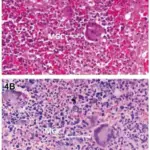Giant cell (temporal) arteritis is a disease caused by the T-cell immune response that affects the large temporal arteries characterized by inflammation.
What is the Pathology of Giant Cell Arteritis?
The pathology of giant cell (temporal) arteritis is:
-Etiology: The cause of giant cell (temporal) arteritis is unknown.
-Genes involved: Unknown.
-Pathogenesis: The sequence of events that lead to giant cell (temporal) arteritis is not well known but it is characterized by intimal hyperplasia and luminal obstruction leading to ischemia and finally swelling of the blood vessels occurs.
-Morphology: The morphology associated with giant cell (temporal) arteritis shows nodular intimal thickening, lymphocytes, and macrophages, with multinucleated giant cells.
-Histology: The histology associated with giant cell (temporal) arteritis shows thickened intima, laminal necrosis, giant cells, and lumen occlusion.
How does Giant Cell Arteritis Present?
Patients with giant cell (temporal) arteritis typically are females present at the age range of 65-80 years. The symptoms, features, and clinical findings associated with the giant cell (temporal) arteritis include headache, tenderness of the scalp, anorexia, weight loss, fatigue, tongue claudication anemia, fever, diplopia, enlarged blood vessels.
How is Giant Cell Arteritis Diagnosed?
Giant cell (temporal) arteritis is diagnosed with a biopsy, ESR, ultrasound, and doppler.
How is Giant Cell Arteritis Treated?
Giant cell (temporal) arteritis is treated with steroids, and prednisolone.
What is the Prognosis of Giant Cell Arteritis?
The prognosis of giant cell (temporal) arteritis is good since they respond well to treatment. However, there is a chance of vision loss.



